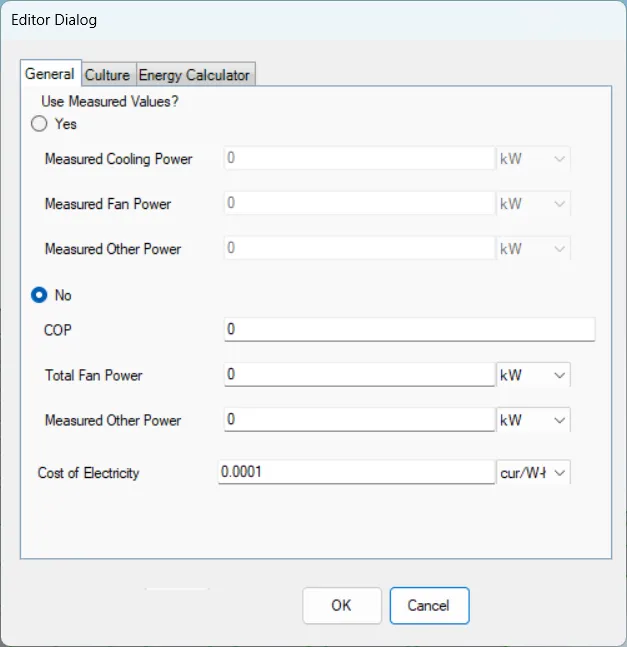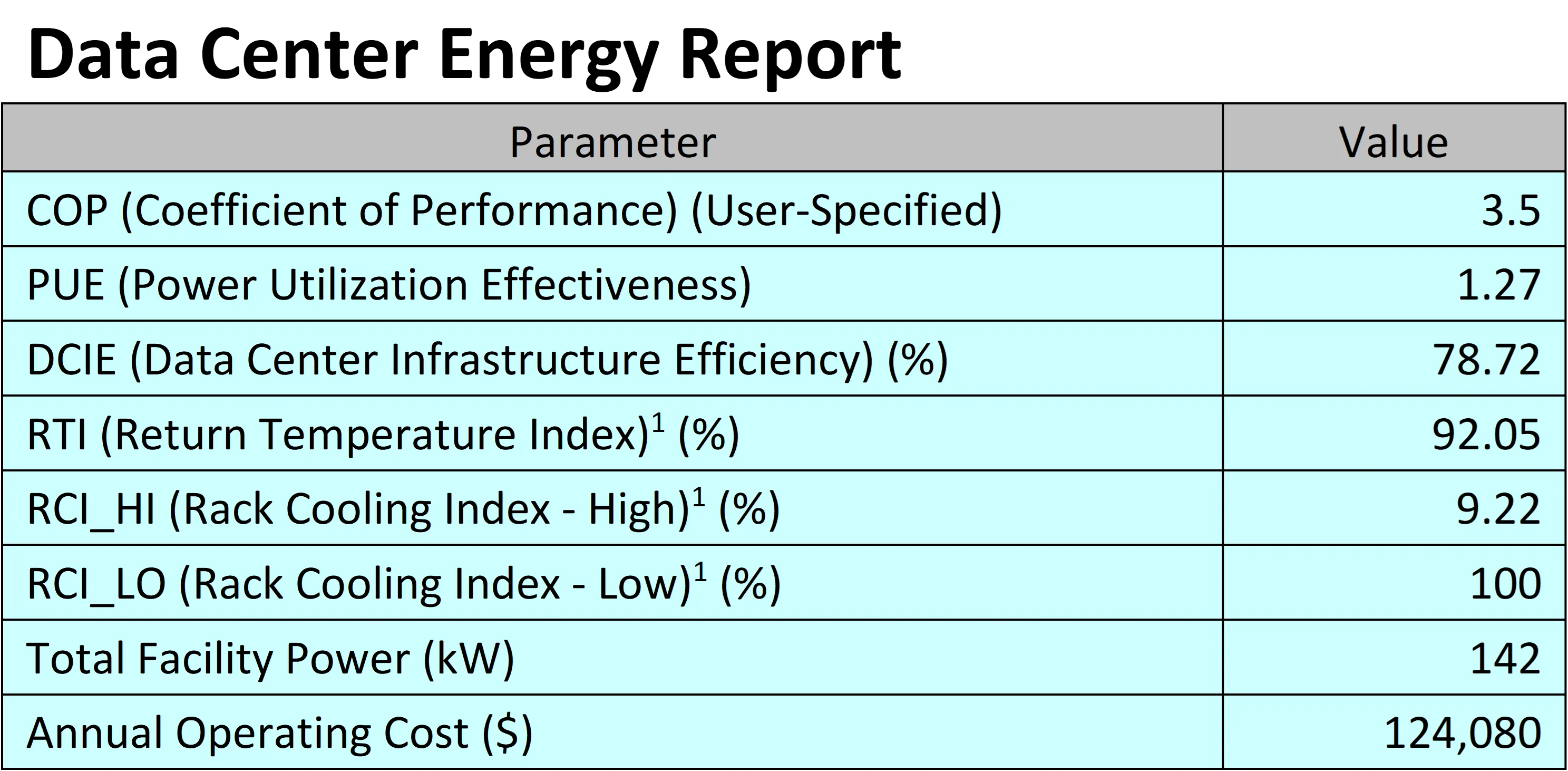TN101: Data Center Energy Calculations in CoolSim
Introduction
CoolSim 4 offers the option to perform data center energy calculations. User-specified data as well as the results of the CFD calculation are combined to compute a number of standard data center energy metrics, which are reported after the calculation is complete. This document shows how to enter the necessary energy parameters and explains how the energy metrics are calculated.
Setup
The user-specified values are set up in the CoolSim interface. In the Edit/Energy Calculation panel (Figure 1), there are two options for performing the energy calculations: using power measurements (Use Measured Values) or not using power measurements.

Figure 1
The Energy Calculation Form
A choice of Yes means that measured values for cooling, fan, and other power will be used to compute the energy parameters. The cooling power is that needed to run the chillers, condensers, or other equipment used for heat exchange. The fan power is that required to run the cooling equipment fans (only). Other power includes lights and any other heat-generating sources, excluding the servers and power distribution units. A choice of No, the default, means that the user-specified coefficient of performance (COP) will be used to perform the energy calculations. The COP is a rating given to the heat pump (condenser or chiller, for example) which is used to remove the heat from the room. COP values usually range from 2 to 5, with better heat pumps being characterized by higher numbers. A lower mid-range default value of 3 is used in the panel. If the COP option is used for the energy calculations, a measurement of other power, as defined above, can be included as well.
Energy Calculations
A Data Center Energy Report (Figure 2) is included in the Summary Report once the calculation is complete.

Figure 2
The Data Center Energy Report
Descriptions of how each calculation is done are presented below.
Coefficient of Performance (COP)
The heat exchanger portion of the CRAC is a heat pump, whose job it is to move heat from one location (inside the room) to another (outside). Heat pumps are rated by their coefficient of performance, or COP. The COP is simply the ratio of the heat moved by the pump to the work done by the pump to perform this task.
Using more practical terms, the COP is the ratio of the total room heat load (power) to the power needed to run the chillers, condensers and other heat rejection equipment. If the COP is specified by the user (after responding No to Use Measured Values), the value appears on the first line of the table with the designation User-Specified. If the user enters measurements for cooling and fan power (after responding Yes to Use Measured Values), these are combined to form the total cooling power, TCP. The total thermal load, TTL, is computed by adding together the equipment heat load (racks and PDUs), the power lost to or gained by the walls of the room, and the user-specified fan power and other power.
Note that the fan power is included in both the total cooling power and the total thermal load. This is because the power delivered to the fans ultimately is dissipated in the form of heat, which must be removed.
Using the TCP and TTL, the COP can be calculated using:
\[COP=\frac{\text{heat moved}}{\text{work done}}=\frac{TTL}{TCP}\]Power Utilization Effectiveness (PUE)
The power utilization effectiveness, or PUE, is a measure of the overall performance of the data center, not just the heat exchangers, which are characterized by the COP. The concept of PUE as a data center metric was devised by a consortium known as The Green Grid. First, the total facility power, TFP, is computed. It is the sum of the total cooling power and the total thermal load:
\[TFP=TCP+TTL\]Next the total IT load, TIL, is computed. Taken from the CoolSim model, it is the sum of the total rack and PDU heat load. Finally, the PUE is computed as the ratio of the total facility power to the total IT load:
\[PUE=\frac{TFP}{TIL}\]Data Center Infrastructure Efficiency (DCIE)
The data center infrastructure efficiency, or DCIE, also developed by The Green Grid, is the inverse of the PUE expressed as a percentage:
\[DCIE=\frac{100}{PUE}\]Return Temperature (RTI)
The return temperature index, RTI, is a trademark of ANCIS, Inc. Expressed as a percentage, it compares the average temperature drop across the heat removal equipment (CRACs) to the average temperature rise across the heat generating equipment (racks and PDUs). Equivalently, it can be expressed as the ratio of the total demand air flow (DAF) to the total supply air flow (SAF):
\[RTI=\frac{DAF}{SAF}\]Rack Cooling Index (RCI)
The rack cooling index, RCI, also a registered trademarked of ANCIS Inc., is computed using the average number of degrees that the rack inlet temperature falls above (or below) the ASHRAE recommended temperature range (64.4°F to 80.6°F). Two rack cooling indices are shown, both expressed as percentages. RCIHI provides a measure of the prevalence of equipment with rack inlet temperatures above the ASHRAE recommended maximum. RCILO is the equivalent calculation on the low side of the ASHRAE recommended temperature range. For the high side:
\[RCI_{HI}=1-\left(\frac{\sum^n_{i=1}\left(T_i-T_{R,\,HI}\right)}{N\left(T_{A,\,HI}-T_{R,\,HI}\right)}\right)\]where:
- \(T_{R,\,HI}\) is the ASHRAE recommended maximum temperature (80.6 °F)
- \(T_{A,\,HI}\) is the ASHRAE allowed maximum temperature (90 °F)
- \(T_i\) is the maximum inlet temperature on the \(i^{th}\) rack
- \(n\) is the number of racks with \(T_i > T_{R,\,HI}\)
- \(N\) is the total number of racks in the sample
The index on the low side is similarly defined:
\[RCI_{LO}=1-\left(\frac{\sum^n_{i=1}\left(T_{R,\,LO}-T_i\right)}{N\left(T_{R,\,LO}-T_{A,\,LO}\right)}\right)\]where:
- \(T_{R,\,LO}\) is the ASHRAE recommended miniumum temperature (64.6 °F)
- \(T_{A,\,HI}\) is the ASHRAE allowed maximum temperature (59 °F)
- \(T_i\) is the minimum inlet temperature on the \(i^{th}\) rack
- \(n\) is the number of racks with \(T_i < T_{R,\,LO}\)
- \(N\) is the total number of racks in the sample
Ideally, no racks should be outside the recommended range, so the ideal value is 100% for both indices. Values between 90% and 100% are in the acceptable to good range, while values under 90% are considered poor. For extremely cold supply air, it is possible to have RCILO less than zero. In such cases, the actual value is not reported but “< 0” will appear in the table.
Total Facility Power
The total facility power, defined earlier since it is used in the calculation of PUE, is the sum of the total cooling power, TCP, and the total thermal load, TTL:
\[TFP=TCP+TTL\]In CoolSim 4, the total facility power is only reported in kW.
Annual Operating Cost
One of the entries in the Energy Calculation panel is the Cost of Electricity. The annual operating cost is computed using the total facility power (TFP) and Cost of Electricity. In CoolSim 4, the cost is in units of currency/kWh. With the total facility power in kW, a conversion factor CF is used to change from cost per hour to cost per year:
\[\text{Annual cost}=TFP\times\text{Cost}\times CF\]